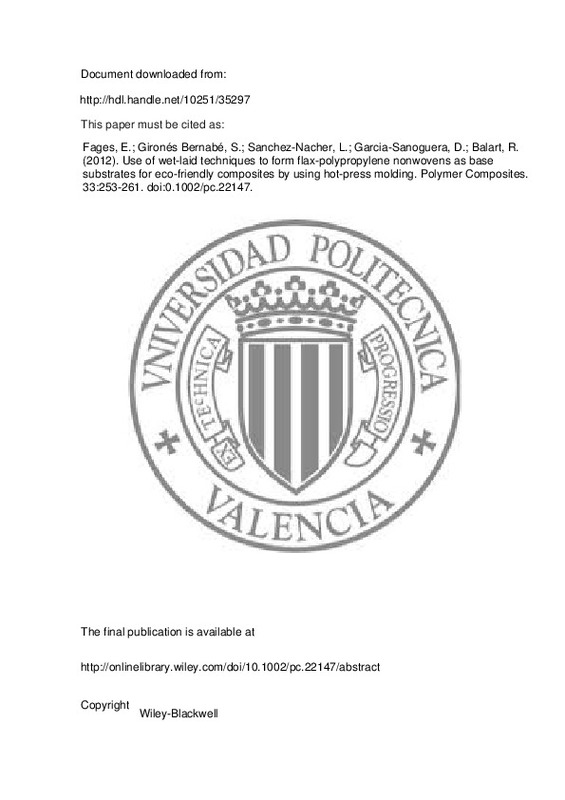Hargitai, H., Rácz, I., & Anandjiwala, R. D. (2008). Development of HEMP Fiber Reinforced Polypropylene Composites. Journal of Thermoplastic Composite Materials, 21(2), 165-174. doi:10.1177/0892705707083949
P.A., S., Joseph, K., G., U., & Thomas, S. (2010). Surface-modified sisal fiber-reinforced eco-friendly composites: Mechanical, thermal, and diffusion studies. Polymer Composites, 32(1), 131-138. doi:10.1002/pc.21028
Pan, P., Zhu, B., Dong, T., Serizawa, S., Iji, M., & Inoue, Y. (2007). Kenaf fiber/poly(ɛ-caprolactone) biocomposite with enhanced crystallization rate and mechanical properties. Journal of Applied Polymer Science, 107(6), 3512-3519. doi:10.1002/app.27470
[+]
Hargitai, H., Rácz, I., & Anandjiwala, R. D. (2008). Development of HEMP Fiber Reinforced Polypropylene Composites. Journal of Thermoplastic Composite Materials, 21(2), 165-174. doi:10.1177/0892705707083949
P.A., S., Joseph, K., G., U., & Thomas, S. (2010). Surface-modified sisal fiber-reinforced eco-friendly composites: Mechanical, thermal, and diffusion studies. Polymer Composites, 32(1), 131-138. doi:10.1002/pc.21028
Pan, P., Zhu, B., Dong, T., Serizawa, S., Iji, M., & Inoue, Y. (2007). Kenaf fiber/poly(ɛ-caprolactone) biocomposite with enhanced crystallization rate and mechanical properties. Journal of Applied Polymer Science, 107(6), 3512-3519. doi:10.1002/app.27470
Khan, M. A., & Hassan, M. M. (2006). Effect of γ-aminopropyl trimethoxy silane on the performance of jute–polycarbonate composites. Journal of Applied Polymer Science, 100(5), 4142-4154. doi:10.1002/app.23441
De Arcaya, P. A., Retegi, A., Arbelaiz, A., Kenny, J. M., & Mondragon, I. (2009). Mechanical properties of natural fibers/polyamides composites. Polymer Composites, 30(3), 257-264. doi:10.1002/pc.20558
X. Li, S. Panigrahi, & L. G. Tabil. (2009). A Study on Flax Fiber-Reinforced Polyethylene Biocomposites. Applied Engineering in Agriculture, 25(4), 525-531. doi:10.13031/2013.27454
John, M. J., & Anandjiwala, R. D. (2009). Chemical modification of flax reinforced polypropylene composites. Composites Part A: Applied Science and Manufacturing, 40(4), 442-448. doi:10.1016/j.compositesa.2009.01.007
Leite, M. C. A. M., Furtado, C. R. G., Couto, L. O., Oliveira, F. L. B. O., & Correia, T. R. (2010). Avaliação da biodegradação de compósitos de poli(ε-caprolactona)/fibra de coco verde. Polímeros, 20(5), 339-344. doi:10.1590/s0104-14282010005000063
Christian, S. J., & Billington, S. L. (2011). Mechanical response of PHB- and cellulose acetate natural fiber-reinforced composites for construction applications. Composites Part B: Engineering, 42(7), 1920-1928. doi:10.1016/j.compositesb.2011.05.039
Hodzic, A., Coakley, R., Curro, R., Berndt, C. C., & Shanks, R. A. (2007). Design and Optimization of Biopolyester Bagasse Fiber Composites. Journal of Biobased Materials and Bioenergy, 1(1), 46-55. doi:10.1166/jbmb.2007.005
Bax, B., & Müssig, J. (2008). Impact and tensile properties of PLA/Cordenka and PLA/flax composites. Composites Science and Technology, 68(7-8), 1601-1607. doi:10.1016/j.compscitech.2008.01.004
Bogoeva-Gaceva, G., Avella, M., Malinconico, M., Buzarovska, A., Grozdanov, A., Gentile, G., & Errico, M. E. (2007). Natural fiber eco-composites. Polymer Composites, 28(1), 98-107. doi:10.1002/pc.20270
Ashori, A. (2008). Wood–plastic composites as promising green-composites for automotive industries! Bioresource Technology, 99(11), 4661-4667. doi:10.1016/j.biortech.2007.09.043
Alves, C., Ferrão, P. M. C., Silva, A. J., Reis, L. G., Freitas, M., Rodrigues, L. B., & Alves, D. E. (2010). Ecodesign of automotive components making use of natural jute fiber composites. Journal of Cleaner Production, 18(4), 313-327. doi:10.1016/j.jclepro.2009.10.022
Mohanty, A. K., Misra, M., & Drzal, L. T. (2002). Journal of Polymers and the Environment, 10(1/2), 19-26. doi:10.1023/a:1021013921916
Larsson-Brelid, P., Wålinder, M. E. P., Westin, M., & Rowell, R. (2008). Ecobuild a Center for Development of Fully Biobased Material Systems and Furniture Applications. Molecular Crystals and Liquid Crystals, 484(1), 257/[623]-264/[630]. doi:10.1080/15421400801904666
MacDougall, C. (2008). Natural Building Materials in Mainstream Construction: Lessons from the U. K. Journal of Green Building, 3(3), 1-14. doi:10.3992/jgb.3.3.1
El-Sabbagh, A., Steuernagel, L., & Ziegmann, G. (2009). Processing and modeling of the mechanical behavior of natural fiber thermoplastic composite: Flax/polypropylene. Polymer Composites, 30(4), 510-519. doi:10.1002/pc.20675
Aurich, T., & Mennig, G. (2001). Flow-induced fiber orientation in injection molded fit fiber reinforced polypropylene. Polymer Composites, 22(5), 680-689. doi:10.1002/pc.10570
Andersons, J., Spārniņš, E., & Joffe, R. (2006). Stiffness and strength of flax fiber/polymer matrix composites. Polymer Composites, 27(2), 221-229. doi:10.1002/pc.20184
Saiah, R., Sreekumar, P. A., Gopalakrishnan, P., Leblanc, N., Gattin, R., & Saiter, J. M. (2009). Fabrication and characterization of 100% green composite: Thermoplastic based on wheat flour reinforced by flax fibers. Polymer Composites, 30(11), 1595-1600. doi:10.1002/pc.20732
Siaotong, B. A. C., Tabil, L. G., Panigrahi, S. A., & Crerar, W. J. (2010). Extrusion Compounding of Flax-Fiber-Reinforced Polyethylene Composites: Effects of Fiber Content and Extrusion Parameters. Journal of Natural Fibers, 7(4), 289-306. doi:10.1080/15440478.2010.527680
Twite-Kabamba, E., Mechraoui, A., & Rodrigue, D. (2009). Rheological properties of polypropylene/hemp fiber composites. Polymer Composites, 30(10), 1401-1407. doi:10.1002/pc.20704
S.R. Wang T.H. Yan J.H. Jiang N.L. Chen Proceedings of the 2009 International Textile Science and Technology Forum 2010
H. Hargitai I. Racz R. Anandjiwala Development of HEMP Fiber Reinforced Polypropylene Composites 2007
Chen, J. Y., Müller, D. H., König, C., Nießen, K., & Müssig, J. (2010). Spunlaced Flax/Polypropylene Nonwoven as Auto Interior Material: Acoustical and Fogging Performance. Journal of Biobased Materials and Bioenergy, 4(4), 330-337. doi:10.1166/jbmb.2010.1097
Yan Chen, Müller, D. H., Nießen, K., & Müssig, J. (2008). Spunlaced Flax/Polypropylene Nonwoven as Auto Interior Material: Mechanical Performance. Journal of Industrial Textiles, 38(1), 69-86. doi:10.1177/1528083707087832
JOLLY, M., & JAYARAMAN, K. (2006). MANUFACTURING FLAX FIBRE-REINFORCED POLYPROPYLENE COMPOSITES BY HOT-PRESSING. International Journal of Modern Physics B, 20(25n27), 4601-4606. doi:10.1142/s0217979206041756
Niu, H., Jiao, X., Wang, R., & Zhou, H. (2010). Direct manufacturing of flax fibers reinforced low melting point PET composites from nonwoven mats. Fibers and Polymers, 11(2), 218-222. doi:10.1007/s12221-010-0218-2
Mieck, K.-P., Lützkendorf, R., & Reussmann, T. (1996). Needle-Punched hybrid nonwovens of flax and ppfibers-textile semiproducts for manufacturing of fiber composites. Polymer Composites, 17(6), 873-878. doi:10.1002/pc.10680
[-]







![[Cerrado]](/themes/UPV/images/candado.png)


